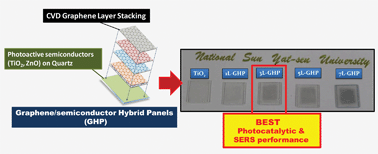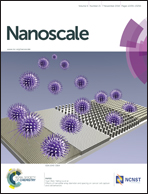Graphene thickness-controlled photocatalysis and surface enhanced Raman scattering†
Abstract
Exceptional photocatalytic enhancement of graphene-semiconductor composites has been widely reported, but our understanding of the role that graphene plays in this enhancement remains limited, which arises from the difficulty of precisely controlling graphene hybridization. Here we present a general platform of a graphene–semiconductor hybrid panel (GHP) system wherein a precise number of layers of graphene are hybridized with photoactive semiconductors (e.g. TiO2, ZnO) to study systematically how graphene affects the photocatalysis. The results show that the graphene enhancement of the photocatalysis depends on the number of graphene layers, with the maximum performance observed at 3 layers. Photodeposited indicators of gold particles further reveal that graphene thickness governs the density of photocatalytic sites and charge transfer efficiency at the graphene–semiconductor interfaces. We suggest that quantized energy levels caused by different numbers of stacked graphene sheets along the vector normal to the graphene basal plane affect the charge transfer routes and lead to the graphene thickness-controlled photocatalysis. GHP substrates deposited with gold particles are promising, uniform substrates for surface enhanced Raman scattering (SERS) applications with the enhancement factor as high as ∼108 on 3-layer graphene.


 Please wait while we load your content...
Please wait while we load your content...